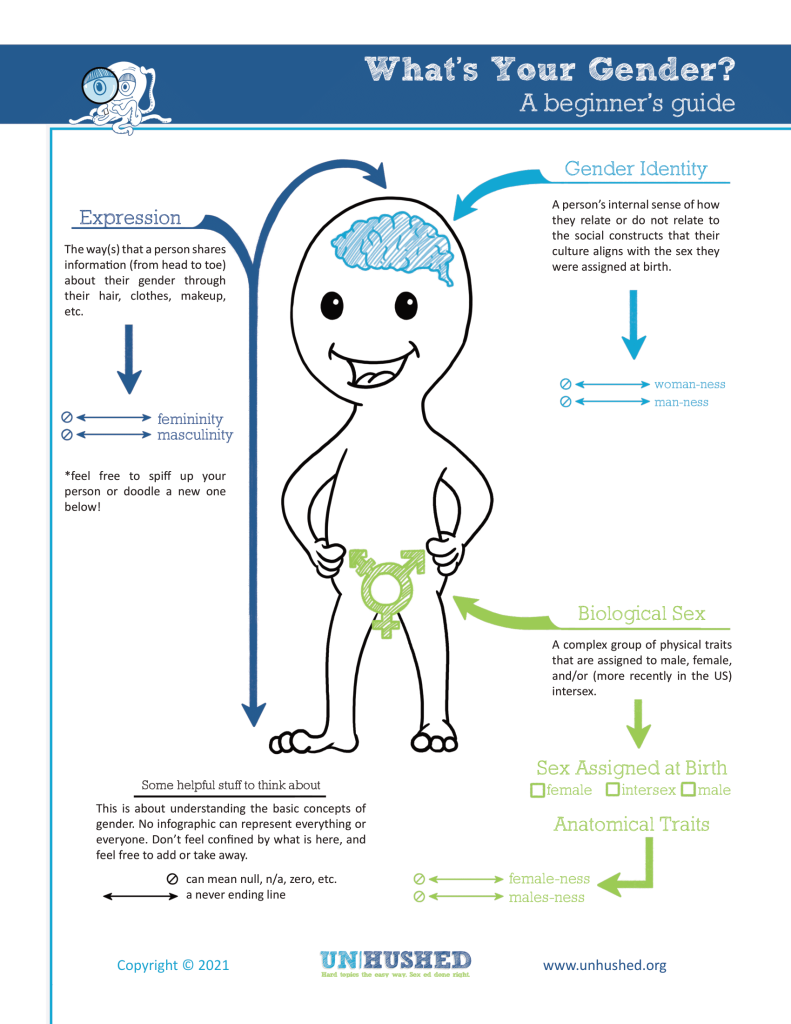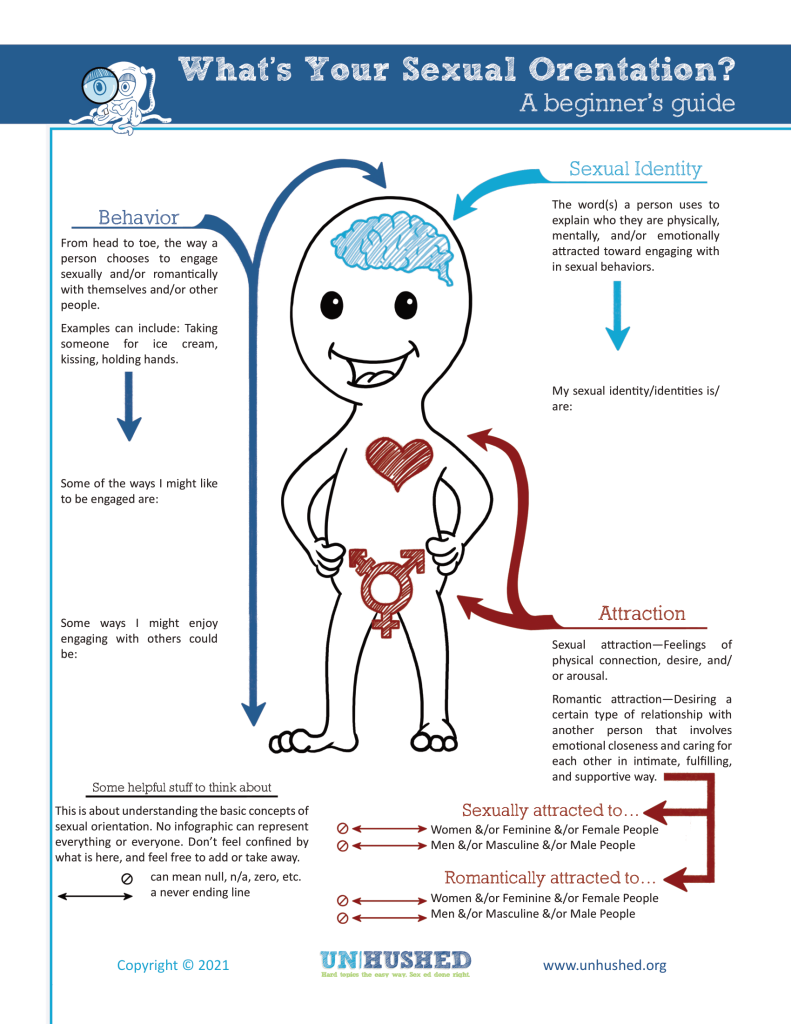


Many people in our society believe that sex and gender are pretty straightforward. You can either be a male or female according to biological sex characteristics (a combination of chromosomes, hormones, and internal and external genitalia) that are identified at birth. In contrast, gender is about what society defines as appropriate expressions of our identities and physical bodies, typically in terms of masculinity and femininity. As you can see, male/female and masculinity/femininity is understood as binary – you’re either one or the other. In addition, people typically see sex and gender as going together in predictable ways – for example, biologically male (as determined by medical professionals) equals masculine, which equals a sexual and romantic orientation towards biological females.
However, sex and gender are a lot more complex than that!
Myth: Biological sex determines gender. In other words, a person’s chromosomes, hormones, and genitalia determine how they see themselves, how they interact with others, and the activities they engage in, and they do so in a predictable way (as noted above).
Fact: Biological factors may affect or be related to how people experience their gender, but they don’t completely determine that experience. Furthermore, gender identity, gender expression, biological sex, and sexual orientation are independent of one another. People’s sexual orientation doesn’t determine their gender expression, their gender expression isn’t determined by their gender identity, their gender identity isn’t determined by their biological sex, and so on.
Finally, “biological sex” isn’t a simple concept either. We often define sex in part by looking at someone’s chromosomes, but there are people who have XXY, XYY, or XXX chromosomes! We also often define sex in part by identifying someone’s anatomy, but approximately 2% of people across the world are born with some kind of sex ambiguity – for example, this could mean that someone can be born with testes as well as a vulva or vagina, or their genitalia may be ambiguous in appearance. These people are said to be intersex. (For more information, check out Emily Quinn’s TED talk video to the left!)
Myth: Men and women are fundamentally different, in large part due to the aforementioned biological differences. This extends to sexual behavior – men are promiscuous and sexually aggressive, while women tend towards monogamy and respond to men’s advances.
Fact: We learn how to act in a feminine and masculine way, and this is reinforced from the time we were born (or even before that!). Think about it: the gender reveal parties you can see on TikTok or Youtube generally involve a display of pink or blue to indicate the parents are having a boy or a girl. We’re also held accountable for the way we do or don’t fulfill gender expectations throughout our lives, including those related to sexual behavior (for example, this is what “slut-shaming” is all about). When all of these experiences are added up over time, the messages that are conveyed teach people what is expected of them in terms of their gender.
Myth: A person’s gender can’t change over time – you’re either male or female from birth to death, and you have no other options.
Fact: Many people’s understandings and experiences of gender are consistent throughout their lives. For others, that’s not the case!
Ultimately, gender isn’t a fixed binary – it’s really a spectrum. There are an infinite number of ways someone can experience gender, and not all cultures adhere to the same dualistic system we have. Click below for a map of gender-diverse cultures – there may be more than you realize!
https://www.pbs.org/independentlens/content/two-spirits_map-html/
“I’m a cisgender woman. I use the pronouns she and hers.”
How many of you have heard someone say that, or something similar? And how many people here personally know someone who has asked you to use different pronouns? In either case – what was your response at the time?
In English, there are two sets of gendered pronouns that most of us use – “she/her/hers” and “he/him/his”. Men have been typically referred to using he/him/his, and women by using she/her/hers. However, some might use different pronouns – “they/them”, for example. When people tell you their pronouns, they’re sending a message about who they are as a person. That applies to cisgender people, too – by introducing yourself with your pronouns, you’re showing people that you’re an ally as well as normalizing the action.
On the other hand, when you don’t respect people’s pronouns, this is what you communicate to them:
Obviously, these statements are harmful – and for that reason, disrespecting someone’s pronouns is not OK!
(Note: the statements above are taken from:
Click the link for additional examples and an explanation of each.


Sexual orientation describes the gender(s) someone is attracted to in relation to their own. Some examples of one’s sexual orientation include straight, lesbian, gay, and bisexual, but there are many others. In our society, we’re expected to be heterosexual; this leads to discrimination and microaggressions against those who aren’t.
However, we ALL need to accept each other! Bisexuality, pansexuality, and the like are often dismissed as “just a phase” by straight and queer folks alike. However, this isn’t true! Furthermore, in our culture, we’re not just expected to be straight. We’re expected to be sexual, period. Those who aren’t following that norm are often thought to have experienced trauma, are assumed to be religious, or are believed to have health issues (depression, for example). To be clear: all of those things are OK! However, there are plenty of folks who identify as asexual – in other words, they don’t necessarily experience desire in the same way (although there can be many ways to be asexual).
This brings us to another point – there’s a difference between sexual and romantic orientation. Though most people use “sexual orientation” as a catch-all to describe the genders they are romantically and sexually attracted to, some prefer to separate the two. In particular, someone can be asexual (low or absent sexual attraction to any gender) and have a romantic attraction to women. In this case, they may describe their sexual orientation as asexual and their romantic orientation as lesbian.
And finally, did you know that heterosexuality as a concept is relatively new? It’s true – people just started talking about sexual orientation as innate to the person in the mid-to-late 19th century! As we can see, concepts change and grow over time – and so do we!
Refers to the determination of an infant’s sex at birth. In the majority of births, a relative, midwife, nurse or physician inspects the genitalia when the baby is delivered, and sex is assigned, without the expectation of ambiguity.
A person’s internal sense of being male, female, neither of these, both, or another gender(s). Everyone has a gender identity, including you! For transgender people, their sex assigned at birth and their own internal sense of gender identity are not the same.
Refers to the physical manifestation of one’s gender identity through clothing, hairstyle, voice, body shape, etc. Most transgender people seek to make their gender expression (how they look) match their gender identity (who they are), rather than their sex assigned at birth. Gender expression is interpreted by others perceiving your gender based on traditional gender roles (e.g., men wear pants, women wear dresses).
Gender expression is something that often changes from day to day, outfit to outfit, event or setting to event or setting. It’s about how the way you express yourself aligns or doesn’t with traditional ways of gendered expression. And like gender identity, there is a lot of room for flexibility here. It is likely that you slide around on this continuum throughout the week without even thinking about it. For example, women in the US now typically wear pants too – that wasn’t the case 100 years ago!
The process by which a society assigns or ascribes a gender and/or sex onto a person with or without (usually without) knowing concretely what sex or gender that person actually is. Often these distinctions are made by looking at a person’s appearance or behavior.
The term for someone who exclusively identifies as their sex assigned at birth. A cisgender/cis person is not transgender. “Cisgender” does not indicate biology, gender expression, or sexuality/sexual orientation. In discussions regarding trans issues, one would differentiate between women who are trans and women who aren’t by saying trans women and cis women. However, many feel that this creates a problematic distinction between the two.
 A term that encompasses the various gender identities of those who do not identify or exclusively identify with their sex assigned at birth. The term “transsexual” is no longer used and is seen as offensive.
A term that encompasses the various gender identities of those who do not identify or exclusively identify with their sex assigned at birth. The term “transsexual” is no longer used and is seen as offensive.
 Terms commonly used by people who do not identify or express their gender within the gender binary. Those who identify as non-binary may identify as neither male nor female, may see themselves as outside of or in between the binary gender boxes, may experience their gender as fluid, or may simply feel restricted by gender labels.
Terms commonly used by people who do not identify or express their gender within the gender binary. Those who identify as non-binary may identify as neither male nor female, may see themselves as outside of or in between the binary gender boxes, may experience their gender as fluid, or may simply feel restricted by gender labels.
 As mentioned above, people with a less common combination of hormones, chromosomes, and anatomy that are used to assign sex at birth. Parents and medical professionals usually coercively assign intersex infants a sex and have, in the past, been medically permitted to perform surgical operations (like amputating an organ that is considered “too short” to be a penis, but “too long” to be a clitoris) to conform the infant’s genitalia to that assignment. This practice has become increasingly controversial as intersex adults speak out against the practice.
As mentioned above, people with a less common combination of hormones, chromosomes, and anatomy that are used to assign sex at birth. Parents and medical professionals usually coercively assign intersex infants a sex and have, in the past, been medically permitted to perform surgical operations (like amputating an organ that is considered “too short” to be a penis, but “too long” to be a clitoris) to conform the infant’s genitalia to that assignment. This practice has become increasingly controversial as intersex adults speak out against the practice.
The term “intersex” is not interchangeable with “transgender” (although some intersex people do identify as transgender).
 Bisexual refers to someone who is attracted to more than one gender. This can include someone who is attracted to all, a few, or just two.
Bisexual refers to someone who is attracted to more than one gender. This can include someone who is attracted to all, a few, or just two.
Refers to someone who is attracted to all genders or attracted regardless of gender. Many people use pansexual to specify that gender is not a factor when determining potential partners.
 Asexuality is a spectrum that can refer to someone who has no sexual attraction, someone who only experienced sexual attraction after a deep emotional connection has formed (known as demisexuality), or a multitude of other definitions.
Asexuality is a spectrum that can refer to someone who has no sexual attraction, someone who only experienced sexual attraction after a deep emotional connection has formed (known as demisexuality), or a multitude of other definitions.
 Lesbian refers to a woman or non-binary person who is only attracted to women and/or non-binary people. An alternate definition is “non-man only attracted to other non-men”.
Lesbian refers to a woman or non-binary person who is only attracted to women and/or non-binary people. An alternate definition is “non-man only attracted to other non-men”.
 Gay refers to anyone that is only attracted to the same gender. While it is often used as a catch-all term for the entire LGBTQ+ community, gay men also use this to describe their attraction to other men. “Gay” is also inclusive of non-binary people, similar to the way “lesbian” is.
Gay refers to anyone that is only attracted to the same gender. While it is often used as a catch-all term for the entire LGBTQ+ community, gay men also use this to describe their attraction to other men. “Gay” is also inclusive of non-binary people, similar to the way “lesbian” is.
 Queer can refer to anyone that is not cisgender and heterosexual. Anyone who identifies as any of the orientations above could call themselves queer. Some also use queer as their only sexual orientation label.
Queer can refer to anyone that is not cisgender and heterosexual. Anyone who identifies as any of the orientations above could call themselves queer. Some also use queer as their only sexual orientation label.
The information on this site is for educational purposes only. It does not replace a personal relationship with a licensed health care provider and is not intended to provide medical advice. We strongly recommend that you make your health care decisions based on your own research and knowledge of your body, in collaboration with one or more licensed health care providers.
The hosting for this website is provided by SUNY Geneseo as a courtesy, but it is not an official College publication. The statements and opinions expressed in content of this website do not represent the official position or policy of SUNY Geneseo.